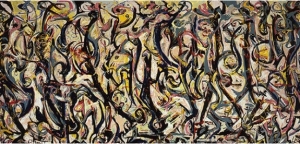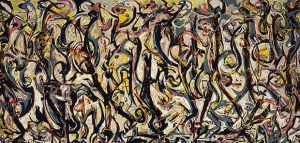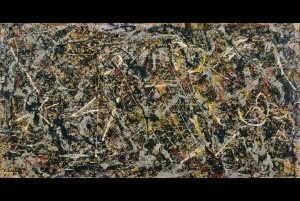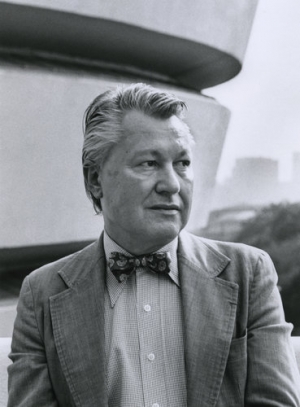|
Displaying items by tag: peggy guggenheim
The Guggenheim family, early Americans who made a fortune in mining, provided its fair share of gossip-column inches in the 20th century. Benjamin Guggenheim, one of 11 children to patriarch Meyer Guggenheim (1828–1905), went down with the Titanic in 1912. He left a widow, Florette Seligman, and three daughters, one of whom would grow up to become the famed art patron Peggy Guggenheim. (Benjamin’s brother Solomon is the man whose name sits atop the Frank Lloyd Wright–designed museum on New York’s Fifth Avenue, which was called both a parking garage and a giant toilet when it debuted. But that’s a whole other story.)
The descendants of heiress and art collector Peggy Guggenheim lost their case in a French court Wednesday over her extensive collection of works housed in an 18th century palace on Venice's Grand Canal.
The French branch of the family launched legal action against the New York-based Solomon Guggenheim Foundation, which manages the collection.
The relatives are angry at the way the collection of paintings by artists including Picasso, Miro and Matisse are displayed and have called for it to be restored to its original configuration.
The descendants of heiress, art collector, and patron Peggy Guggenheim are launching yet another appeal in a French court tomorrow against the Guggenheim Foundation over the management of her vast art collection, housed in an 18th century palazzo on Venice's Grand Canal, AFP reports.
After years of collecting art, Guggenheim settled in Venice, where she purchased Palazzo Venier dei Leoni in 1949.
A court here on Wednesday issued a ruling that permits the Solomon R. Guggenheim Foundation to display art as it sees fit in the Venetian palazzo given to it by the wealthy collector Peggy Guggenheim.
In a 16-page decision, the Paris tribunal rejected legal claims made by a group of her descendants that the foundation was bound to display Guggenheim’s vast collection of modern art the way she had originally presented it in her home.
Her family — seven grandsons and great-grandsons based in France — vowed to appeal after the tribunal dismissed their demands to revoke Guggenheim’s donation to the foundation unless the displays of Cubist, Surrealist and abstract postwar art were returned to their original state without additions of contemporary works.
Today's modern art forger is capable of producing fake works of art so perfect that even trained experts are unable to spot them. Even down to the most minute details of the pigments, binders, and canvas, these fakes are almost better than the works they're based on. But thanks to a byproduct of the Atomic age, the art world has a potent tool for finding forgeries.
Since the start of the 1960s, the art world—especially the modern art world—has been besieged by a torrent of faked "masterpieces." Peggy Guggenheim (yes, that Guggenheim) was once famously duped into purchasing what was believed to be a canvas painting by French artist Fernand Léger completed around 1913. It hung in her private collection for decades before being revealed as a forgery. This problem only expanded through the 1980s and 1990s as the market for modern art exploded.

The J. Paul Getty Museum in Los Angeles announced that its exhibition dedicated to Jackson Pollock’s recently restored “Mural,” has given the museum a welcome boost in attendance. In March, 127,466 patrons visited the Getty, an increase of 3% from the same month in 2013. Last year, the museum also saw an unusually high attendance rate due to an exhibition of Johannes Vermeer’s “Woman in Blue,” which was on loan from the Rijksmuseum in Amsterdam. From 2010 to 2012, average March attendance at the Getty hovered around 97,000.
“Mural," a stunning oil-on-canvas measuring more than 8 feet tall and nearly 20 feet long, recently underwent a year-long restoration at the Getty. Conservators removed a layer of varnish from “Mural,” which now appears much brighter and closer to its original appearance. The work, which was painted in 1943 for the well-known art collector Peggy Guggenheim, represents a turning point in Pollock’s career in which he gravitated towards the abstract expressionist characteristics that define his seminal “drip” paintings. The work belongs to the University of Iowa Museum of Art, which received it as a gift from Guggenheim in 1951.
The Pollock show opened at the Getty on March 11 and details the conservation of the painting. During the first week of the exhibition, the Getty welcomed 29,374 visitors, a 25% increase from the first week of the month. The last week of March saw a 46% jump from the first week of the month.
"Mural" will remain on view at the Getty through June 1.

Jackson Pollock’s “Mural,” a stunning oil-on-canvas measuring more than 8 feet tall and nearly 20 feet long, is currently on display at the J. Paul Getty Museum in Los Angeles. The painting recently underwent an extensive restoration at the Getty Center, which took over a year to complete.
“Mural,” which was painted in 1943 for the well-known art collector, Peggy Guggenheim, represents a turning point in Pollock’s career in which he gravitated towards the abstract expressionism that defined his seminal “drip” paintings. The work belongs to the University of Iowa Museum of Art, which received it as a gift from Guggenheim in 1951.
Restorers removed a varnish that was added to the painting during a 1973 restoration. While the previous conservation effort helped preserve the work, the varnish significantly darkened the painting’s colors. “Mural” now appears much brighter and its colors are closer to their original intensity.
During the restoration process, conservators made a number of new discoveries regarding the Pollock painting. It had long been believed that the artist created “Mural” in a single creative burst that lasted between 24 and 36 hours. Restorers noticed that Pollock’s initial paint marks, which cover the entire canvas, were made in four highly diluted colors, which could have been created in a day. However, the other additions to the canvas would have taken much longer than that to dry. Restorers also confirmed that Pollock used house paint as well as high-quality oil paints to make “Mural.”
“Mural” will remain on view at the J. Paul Getty Museum through June 1. After it leaves Los Angeles, the painting will go on view at the Sioux City Art Center in Iowa for several months.

In June 2013, the Peggy Guggenheim Collection in Venice launched a multi-phase conservation study of paintings by Jackson Pollock. The works, which date from 1942 to 1947, had been acquired directly by art dealer Peggy Guggenheim through her representation of Pollock at her New York gallery, Art of this Century.
During the first phase of the project, ten paintings underwent non-invasive scientific analysis that identified pigments, paint chemistry and changes in composition. The results of this study were presented in October 2013 during a symposium organized by Italy’s Accademia Nazionale dei Lincei and the U.S. Academy of Sciences at the Istituto Italiano di Cultura in New York.
For the second phase of the endeavor, conservators will focus on ‘Alchemy,’ one of Pollock’s most celebrated paintings and one of the artist’s first all-over abstractions created in his Long Island studio. Starting this month, the canvas will undergo analytical study and treatment at the Opificio delle Pietre Dure in Florence. The painting’s surface, which is comprised of various layers of enamel, alkyd, oil paint, twine, sand and pebbles, has been dulled by dirt and grime that has accumulated over the years. The conservation efforts will help brighten the painting’s bold colors and restore its sculptural surface.
The historic Pollock project is the first ever undertaken in Italy.

Thomas M. Messer, the longtime director of the Solomon R. Guggenheim Museum in New York, passed away on Wednesday, May 15, 2013 at his home in Manhattan. Messer served as the institution’s director from 1961 to 1988 when he retired. Messer also served as the director of the Guggenheim Foundation, which is dedicated to promoting the understanding and appreciation of art, from 1980 to 1988.
During his time at the Guggenheim, Messer helped to establish the museum as of one of the finest art institutions in the world. In doing so, he grew its collection, increased its exhibitions program, improved its publications, and helped it to become a global entity.
Messer vastly expanded the Guggenheim’s holdings by acquiring two major private collections. In 1963, Justin K. Thanhauser, the son of a German art dealer, gave the museum a trove of Impressionist, Post-Impressionist, and early modern works including over 30 Picassos. The second bequest came from Peggy Guggenheim who left her entire collection including an array of Cubist, Surrealist, and Abstract Expressionist works to the Guggenheim Foundation. The collection operates as a museum known as the Peggy Guggenheim Collection.
Born in Eastern Europe in 1920, Messer arrived in the United States in 1939. He graduated from Boston University in 1942, joined the army, and served as an interrogator for military intelligence in Europe. After the war, he stayed in Europe and studied art at the Sorbonne. Upon his return back to the United States, Messer was named director of a small museum in New Mexico. He eventually earned a master’s degree in art history from Harvard and was soon appointed director of the Institute of Contemporary Art in Boston.
While he has no surviving family, Messer leaves behind a legacy of diplomatic leadership as well as one of the finest art institutions in the world.

Starting in the 1950s, Rudolph and Hannelore Schulhof began building a 20th century art collection that has become the source of much speculation after the widowed Hannelore died this past February. Boasting nearly 350 works in total, Christie’s will auction 63 pieces from the collection including works by Joan Miro, Ellsworth Kelly, and Robert Indiana as part of its Impressionist and Modern Art Works sale and its Post-War and Contemporary Art sale in November. The sale is expected to bring in about $25 million. Christie’s will open the doors to the Schulhof’s Long Island mansion on Saturday, September 21 and Sunday, September 22 from 10AM to 5PM. Visitors will get a glimpse of an extraordinary, museum-quality collection. In fact, 100 of the works had previously been promised to three museums including the Peggy Guggenheim Collection in Venice as well as the Israeli Museum in Jerusalem and the Whitney Museum of American Art in New York.
The Sculhofs met in Vienna right before the start of World War II and married in Brussels in 1940. After traveling to the United States with extended family, Rudolph launched what would become a fine art reproduction company. When the couple first started collecting they tended to go after established names but were cajoled by the art dealer, Justin Thannhauser, to consider the art of their own time. As the Schulhof’s company had an office in Milan, they would frequent the city’s galleries as well as the Venice Biennale on their visits to Italy. It was on one of these trips that the Schulofs met the prominent American art collector, Peggy Guggenheim. A longtime friendship ensued, resulting in rapports with the artists themselves and the couple’s generous posthumous gift of 83 works to Guggenheim’s Venice institution. Another 200 artworks will remain in the Schulhof’s home and the family will decide on distribution in the future.
|
|
|
|
|